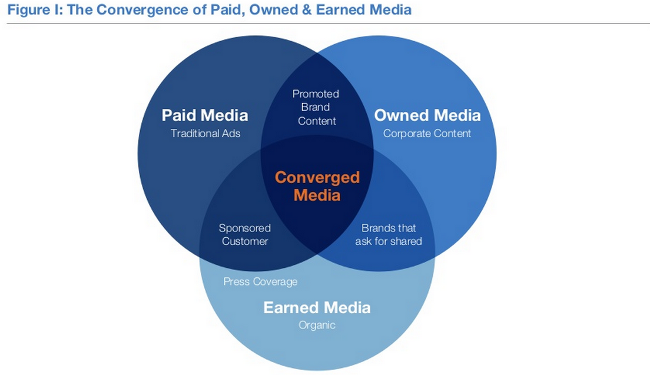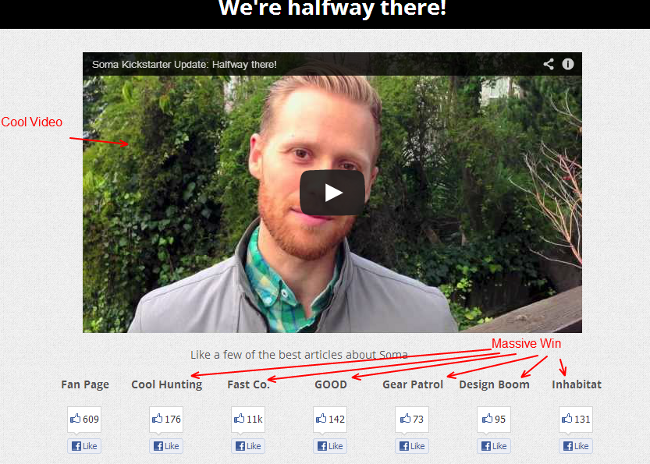 Content marketing evangelists have spoken – “Create great content that appeals to your customers and you’ll profit.”
Content marketing evangelists have spoken – “Create great content that appeals to your customers and you’ll profit.”
While this is true, marketers often forget the importance of promoting their content – people don’t find content by mistake, or by accident. Every content plan needs a complementary promotion plan that combines paid, owned, and earned media.
Beyond Simple Sharing on Corporate Social Accounts
I was watching a video where one content marketing evangelist went through the strategy and creation of content in great detail, but completely ignored the importance of promoting content.
He suggested that marketers should share it from corporate social accounts and with employees so they could choose to share if they wanted.
While these strategies are an acceptable start, they overlook the simple fact that for the vast majority of companies (unless you’re a market-leading megabrand), simply publishing content gets them nothing resembling good results.
It’s like writing the great American novel and leaving it on your doorstep. Or creating a baseball diamond in a cornfield in Kansas. Only in the movies do random strangers find your great things and make them a big deal. In the real world, you have to work hard to get anyone to pay attention to what you’re doing.
But that’s why marketers have jobs right?
Building Your Promotion Plan Across Paid, Earned and Owned Media
While it’s become a something of a buzzword, thinking about your content promotion plan in the ‘Paid-Earned-Owned’ matrix is a useful cognitive pattern.

The Altimeter Group Converged Media Model
Across your company’s paid, owned, and earned channels, how will you promote your beautiful piece of content? How will you get the word out and ensure the right people see it and share it? This can’t be taken care of when your content has been written – these questions have to be answered before you ever start your content creation efforts.
Owned Media: Using Your Permission Marketing Assets
We’ll start with owned assets – they tend to be the simplest to discuss in this context.
Most companies have:
- Some sort of social media presence (be it Facebook, Twitter, LinkedIn, Pinterest, Tumblr, etc.)
- Email lists – of both customers and non-customers
- Blog(s)
- A more static website or series of microsites
Content marketers should develop a plan to promote their content in a unique, platform-native way across all of these assets.
For instance, if you’ve developed an infographic, create some extracts from it with interesting statistics. These make great social updates for Twitter or LinkedIn.
By contrast, for Facebook, you may wish to crop an image of the relevant part of the infographic and share it along with the interesting statistic to take advantage of the prominence that image-centric posts are given in Facebook’s newsfeed.
Finally, if you’re working on content for your website or blog, you can cut up the infographic into its component pieces, and write a blog post that elaborates on each statistics and explains it in greater detail.
You’ll also want to email a link to your list (sometimes in a larger newsletter). At BuzzStream, we’ve found that sharing our best content with our customers via email is an excellent way to get social distribution.
All of these materials should link back to the original graphic. (Incidentally, it’s a good idea to add Twitter Card and Facebook OGP metadata to that page. It’s also effective to host the graphic on a CDN if you’ll ask people to embed it. Taking the time to follow best practices can make content marketing practices dramatically more effective.)
While infographics are often put in the “fun and easy” bucket (they are fun to do well, and easy to do poorly), most of this advice applies to whitepapers, detailed visualizations of internal data, and other pieces of content.
Paid Media: Buying Attention at Bargain Basement Prices
Integrating paid media in content marketing is a topic of much debate – doesn’t the content marketing do that itself?
If you take one thing away from this blog post, the answer is No. Nothing markets itself. The world tends towards entropy, ignorance, and forgetting your company exists.
That being said, I’m not suggesting you hire someone in a gorilla suit to stand by the side of the freeway holding a sign with the title of your latest white paper on it.

The White Paper is in his briefcase.
Why? For starters, it would be difficult to attribute conversions to the person in the gorilla suit. And our tests indicate gorilla suit advertisements convert poorly.
Most direct marketing advertisement methods (paid search, etc.) deliver poor ROIs for content advertising. They’re too expensive, and often deliver people who have the wrong need-state for enjoying some quality content.
Some paid content promotion tactics that can be very effective include:
- StumbleUpon Paid Discovery – StumbleUpon lets you buy clicks at low, low prices fromsocially engaged visitors. These visitors are typically in the college demographic, and are often looking for engaging visual content. Made a new piece of visual or interactive content in a B2C space targeting younger people? This tactic is a great fit.
- Reddit Ads – Similar to StumbleUpon ads, Reddit also has inexpensive clicks from a young, socially engaged audience available. Remember to follow the protocol of the sub-Reddit you’re advertising on– for example, use the AMA or TIL conventions on the relevant subreddits.
For more tips on Reddit and StumbleUpon ads, I recommend this great SlideShare presentation by Brent Csutoras.
- Promoted Tweets – Twitter now allows you to promote individual tweets, which can be a great way to get in front of the right people and join the social conversation. You can target users by interest, gender, geographic, or device – so you can get in front of the right people.
- Highly Targeted Facebook Ads – Facebook enables marketers to target both posts and conventional ads by an amazing variety of criteria. For content promotion, you might want to target people that like WordPress, blogs, or employees of media properties like TechCrunch or Mashable.
- Outbrain – Outbrain is another content promotion ad network – you can advertise for inexpensive traffic on related blogs for audience development.
- Retargeting on Display or Facebook – If you have a retargeting list, you can advertise your content to it inexpensively on AdRoll, or through Google Retargeting.
If you’re interested in building links specifically (and who isn’t), you may enjoy this video presentation from Carson Ward, where he used Reddit and other social ads to promote his content and found he got links at a very affordable price:
When you approach these paid opportunities, they take a slightly different mentality than traditional brand advertisements or direct response ads. You want to encourage people to engage with the content, comment on it, and share. Questions work well, as does taking a page from the social aggregators and asking people to “Check this out” or “Let Us Know What You Think”.
Earned Media: Embracing the Echo Chamber
Earned media is some of the most valuable – and hardest to get – exposure due to its credibility and potential reach. While you might not see the same level of message control, the amount of trust placed in these recommendations is huge.
Earned media can take several forms:
Social Sharing from Individual Accounts
This could happen on networks like LinkedIn, Twitter, Pinterest, Tumblr, Facebook, and whatever the kids are using these days. As far as efficacy, these can very from “Oh, that’s nice,” to driving site-crashing levels of traffic and corresponding increases in sales.
Pickups in Traditional or Trade Media
These are conventional PR placements, but in this case, they’re about your content. What this looks like will depend on your industry – I’ve seen successes range from TechCrunch reporting on aggregated mobile analytics data to USA Today writing about studies from drug rehab centers.
In some (mostly B2B) verticals, pickups in trade media can be more effective than coverage in larger, general interest papers.
Bloggers and Other Influencers Writing About Your Content
These aren’t traditional media but rather individual bloggers writing about your content. There isn’t a hard and fast line between individual bloggers and ‘real’ media anymore – what starts one place can rapidly go to another, and now it’s easy for individual blogger’s posts to get picked up by traditional media.
If you do a lot of outreach to these smaller influencers, you may want to use a tool like BuzzStream to find these people and manage your process.
Prominent Placements on Aggregator Sites Like HackerNews, Reddit, etc.
These sites can send LOTS and LOTS of traffic, especially the two examples above. However, these exist for just about every niche – sometimes they don’t send a lot of traffic, but even if they don’t they’re a good place to reach the curators and other online influencers.
These categories aren’t mutually exclusive anymore. In the past there was a hard line between press, customers, bloggers, analysts, etc., but now everyone is part of one big group of people with online audiences. A story that starts on Twitter gets submitted to HackerNews, picked up on TechCrunch, and then blogged about on smaller publications, etc.
Whenever you launch a piece of content, you should plan for some sort of earned media promotion.
While that can mean letting relevant content curators and writers know you’ve published something good, the best approach is to bake earned media appeal into your content.
What does that mean?
- Create “citable” content – use high-authority research from scientific journals and sources to back up your content. (Greg Ciotti, Chris Dyson, and Derek Halpern all do this very well.)
- Consider where each part of your sub-sections may make a good guest post. For example, if I were to create an ebook about the ‘ultimate guide to content promotion’, I’d try to write a guest post related to the content section on Content Marketing Institute, the social section on Convince & Convert, and the search section on SEOmoz. In each of these sections, I’d make sure I mention those organizations and link back to their most important and useful pieces of content. Then when I approached them for a guest post, I would be in a better position, and visitors from those posts downloading the ebook would feel at home and trust the rest of the content.
- Encourage social sharing – consider making 140 character insights tweetable with one click thru Twitter Web Intents. Also, suggest people follow you on the second click so you can build your audience.
- At the same time, get your metadata right so you look good when shared on social networks – use OGP tags for Facebook and Twitter Card metadata.
- Make a list of publications you want coverage from before you start writing or outlining your content – observe what these people cover and modify your content to match their themes.
- If your content has visual elements, consider licensing them with creative commons and/or making them easy to embed. If you decide to make them embeddable, don’t go nuts on the anchor text – no point in making a mess that you may have to clean up later.
Fusion, Amplification, and Converged Media
In the past, these media types were deeply siloed. Now, they effortlessly flow into one another, where paid promotion of owned media can lead to massive earned media wins, and paid and owned media can amplify earned media and give something with credibility incredible reach.
Planning for Fusion
In a perfect world, your owned and paid media touch off a tornado of earned media, creating that ‘echo chamber effect’ where your content (and thus your brand) appears to be everywhere.
While there are a variety of strategies to do this, ultimately you want to get your initial earned, owned, and paid media out into your audience, and hopefully that will lead to more self-sustaining earned media.
This gets you scale and trust – without SuperBowl sized budgets.
Always remember: Earned media is the most important. Anything a brand or marketer says is immediately suspect, but trusted third parties are just that – trusted third parties. This makes amplifying an earned media win dramatically more valuable than a comparable amplification of owned media or straight paid media.
To create this sort of amplification, use your owned and paid power to boost your earned wins, after pushing your original content.
For example, the creators of beautiful water filter Soma used this page as part of their Kickstarter campaign to invite their email list to like their press wins on Facebook. Earned amplified by Owned = Massive Win:

The whole post where they describe their process is a fascinating example of scaled PR outreach – it’s especially applicable if you like KickStarter, design, or startups.
If you can get a quality earned media win – like a great guest post or a story – immediately after your campaign starts, consider promoting it through paid media and on your own lists. This is a good strategy because:
- More people get exposed to your ideas, your brand, and your content.
- Many publications maintain a “Most Read” or “Most Shared” internal sidebar – as your article climbs this, it will drive more traffic to your content as time goes on.
- Additionally, many publications these days are largely ad driven – if the set of topics around your ‘sweet spot’ becomes widely known at that publication as something that drives traffic, it’s likely you’ll appear in future coverage.
- That win sets you up with social proof to approach other publications with your content and get even bigger earned media wins.
The other tip I can’t recommend enough is to add retargeting pixels to your content as early as possible. These retargeting lists are free to create, and will come in handy when you need to either move your content consumers down a purchasing path, or launch a new piece of content – you can advertise to everyone that interacted with your last piece for a very affordable rate.
Conclusion
Just because you’ve made something great doesn’t mean people will find out about it on their own. Developing a plan to promote your content across paid, earned, and owned media before you even create it is not just a best practice – it’s necessary to be an effective content marketer.
How do you promote your content and use the convergence of POE media to your marketing advantage? Leave any questions or thoughts in the comments.

